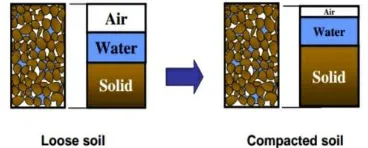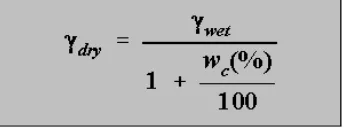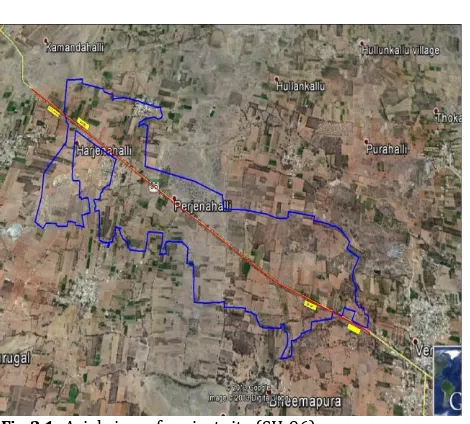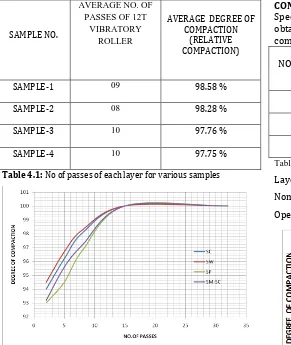© 2015, IRJET ISO 9001:2008 Certified Journal Page
2086
STUDY AND COMPARISON OF SOIL COMPACTION BETWEEN
LABORATORY AND FIELD TO SIMULATE FIELD COMPACTION FOR
RURAL ROADS
Vinay A
1, Hemanth Yadav M V
21
Assistant Professor,
Department of civil Engineering, Dayananda sagar college of Engineering,
Bangalore, Karnataka, India
2
M. Tech Highway Technology, Department of civil Engineering, Dayananda sagar college of Engineering,
Bangalore, Karnataka, India
---***---Abstract
Soil compaction is most prominent level inconstruction of pavement. It enhances engineering designing properties of fill and helps in achieving soil strength and stability. Compaction plays a major role in pavement strength and durability. Proper compaction is necessary to bear heavy axle loads of vehicles. The current situation demands high degree of compaction with limited time and man power, thus helps in completion of project in economical way. The compaction aims to achieving certain dry density in site. The main aim is to provide better technical background to the project also minimize the time delay caused. The project is mainly based on achieving required degree of compaction, by finding optimum number of passes of vibratory roller, dry density achieved with required amount of compaction effort also various parameters of vibratory roller. Soil samples are gathered from different diverse areas and 4 unique sorts of soils are acquired. In situ dry density is acquired from core cutter from every area. The research facility tests are completed discover dry density of every specimen. From this MDD and OMC of every specimen was found out. And subsequently relative compaction was ascertained for distinctive soil sorts. Also found out various equipment parameters affect the soil compaction and calculate the optimum value of each case. This is very logical for better compaction of soil.
Key Words:
Compaction, Relative compaction, Dry
Density, Moisture content.
1. COMPACTION
Compaction is the process of increasing the density of soil by mechanical means by packing soil particles closer together with reduction of air voids and to obtain a homogeneous soil mass having improved soil properties. It is nothing but increasing density by diminishing air voids.
Figure 1.1 Impacts of compaction on pore space
The procedure of soil compaction is just ousting the air from the voids or diminishing air voids. By diminishing the air voids, more soil can be added to the piece. At the point when dampness is added to the square, moisture content increases, the dirt particles will slip all the more on one another bringing on more diminished in the overall volume, which will bring about including more soil and henceforth, the dry density will increment in like manner.
OBJECTIVES:
Decrease future settlements Increase shear strength Decrease permeability
Control undesirable volume changes Increases stability of slope
1.1PURPOSE OF COMPACTION
Soils may be compacted by the straightforward utilization of weight from pedestrian activity, vehicles and also rain drops. The more prominent this weight, the more prominent the soil compaction. The reason for compaction is to enhance the characteristics of the soil utilized either as a sub-level materials for roads or in the fills of any task. The major principles in which soil must be compacted are:
capacity of bearing the load increases Settlement of soil can be avoided. More stability can be achieved.
© 2015, IRJET ISO 9001:2008 Certified Journal Page
2087
1.2 FACTORS AFFECTING COMPACTION IN THE FIELD Compactive Effort Water Content Type of Soil Contact Pressure Thickness of Layer
Number of Passes of Roller
1.3COMPACTION MEASUREMENT
The level of compaction of soil is measured by its unit weight or dry density and ideal dampness content (WC). Dry density is the heaviness of soil solids per unit volume of the dirt in mass. By having the wet unit weight and the dampness content (WC), the dry unit weight can be resolved from:
1.4
TYPES OF COMPACTIONMainly there are four different types for compacting soil: vibrating
Kneading
Pressure
Impact
All these types can be shown in two main types: 1. Compaction by Static Weight of Roller 2. Compaction by Vibratory Mass in Roller
1. COMPACTION BY STATIC WEIGHT OF ROLLER
Static compaction can be accomplished by the deadweight of the compaction roller. Smooth wheeled rollers and pneumatic tired rollers are utilized for static compaction. With coupled rollers compaction is impacted by the static direct load (kg/cm) of the drum, with pneumatic tired rollers by the wheel load (t) and the tire expansion weight (M Pa). Contrasted and vibratory compaction the compaction exertion is generally less
Static compaction finished with pair rollers just when the beginning compaction by the finisher was low, if the bitumen blend is anything but difficult to minimize.
In this the massaging and flexing impact of wheels in pneumatic tired rollers
accomplish an exceptional quality in static compaction. It prompts a uniform conveyance of the blend and shuts the pores of the surface.
2. COMPACTION BY VIBRATORY MASS IN ROLLER
Vibratory rollers are all the more effective, adaptable and successful and can require extensively less number of goes than static rollers. The vibration from rollers lessens the inner grinding in the mineral blend, so the cooperation between element burden and dead weight of the roller builds the thickness. Other than static straight load, additionally components, for example, frequency, vibrating mass, and amplitude are likewise contributes on compaction exertion.
1.5 RELATIVE COMPACTION
Relative compaction is the rate proportion of the field dry density of soil to the most extreme dry density as dictated by standard compaction system. Once the greatest dry unit weight has been set up for the dirt being utilized as a part of the compacted fill, we shall express the level of compaction accomplished in the field by utilizing the relative compaction,
Where:
γ d = dry density obtained in field
γd(max) = maximum dry density (from proctor test)
Table 1.1 Typical Compaction Requirements
1.6COMPACTION EQUIPMENT PARAMETERS
© 2015, IRJET ISO 9001:2008 Certified Journal Page
2088
The static direct load is computed by isolating the piece ofthe aggregate roller weight conveyed by every drum by the width of the drum. Static direct load is typically exhibited in kg/cm, KN/m . The static straight load has an impact on the capacity of a roller to achieve a high level of compaction
AMPLITUDE
The nominal amplitude is depicted as a large portion of the travel separation (vertical or flat) of the drum. As the stabilizer turns, the drum moves inverse to the stabilizer. This implies that when the weight is at highest position, the drum is at least point. The amplitude has awesome influence in deciding the greatest layer thickness for a roller.
FREQUENCY
The vibration frequency must be chosen in connection to the material to be compacted what’s more, the abundance of the roller. Through examination and experience it has been found that higher frequencies are remarkable for bitumen compaction contrasted with lower frequencies
Fig 1.2: Typical Cycle of Vibration
2. METHODOLOGY
2.1 PROJECT SITE
Project work site is at kolar – chikkballapur state highway (SH -96).the stretch is approximately 4 km from vemgal and passing perjenahalli and harjenahalli along newly developed KIADB industrial layout which is 17 km from kolar city
Fig 2.1: Arial view of project site (SH-96)
2.2 Road Network
Approach to the proposed industrial area is through existing Kolar- Chikkballapura road (SH-96). The carriage way width is 15 m. The existing road is widened to 24 m and 12m wide service roads are provided on either side of the existing road to provide hurdle less movement of vehicles. About 29 nos. of local streets of 18 m, 15 m & 12 m widths are proposed which provides connectivity to the individual plots. Each road has been provided with concrete side drains on either side. Only for 24 m wide road, median and street lights are provided. Each road is suitably designed and provided with designed Granular Sub Base, Wet Mix Macadam, Dense Bituminous Macadam and Bituminous Course
2.3 SOIL SAMPLE
Soil properties are controlled by both field and lab test techniques. Soil test is gathered up and down the roadway in crisscross way at each 50m interim from the town vemgal at '0 m chainage to chainage of 3905 m. The specimen must speak to the genuine soil utilized for development. The example acquired is tried in lab for its properties i.e. degree, particular gravity, Atterberg limits and so forth. The gathered soil test acquired in task site can separated into 4 sub tests in light of same example is utilized for certain length. In this manner,
CHAINAGE(m) SAMPLE
O to 1200 Sample-1
1250 to 2100 Sample-2
2150 to 3200 Sample-3
3250 to 3905 Sample-4
© 2015, IRJET ISO 9001:2008 Certified Journal Page
2089
2.4 SOIL TESTS CONDUCTEDNUMBER TESTS CONDUCTED ON SOIL
1 Moisture content
2 Specific gravity test
3 Sieve analysis
4 Consistency limit tests
5 Proctor Compaction test
Table 2.2: Tests conducted on Soil.
3. FIELD AND LABORATORY
INVESTIGATION
3.1 SPECIFIC GRAVITY
Specific Gravity tests are conducted from Pycnometer tests and results are tabulated
NUMBER SPECIFIC GRAVITY
SAMPLE-1 2.66
SAMPLE-2 2.69
SAMPLE-3 2.71
SAMPLE-4 2.69
Table3.1: Specific Gravity of Soil Samples
3.2 CLASSIFICATION OF SAMPLES
Classification of samples is done based on soil gradation test and atterberg limits tests.
SL. NO CU CC WL
(%) PI
(%)
IS SOIL CLASSIFICATION
SAMPLE-1 11.3 0.477 34.5 19.04 SC
SAMPLE-2 9 1.36 32 19.64 SW
SAMPLE-3 3.53 0.88 24.8 14.59 SP
SAMPLE-4 6.38 0.735 23 11.63 SM-SC
Table3.2: IS Classification of Soil Samples
3.3 DRY DENSITY CALCULATION FROM LAB
Dry density of each samples are calculated in lab by modified compaction test and results are tabulated.
SAMPLES LAB MDD (g/cc) OMC (%)
SAMPLE-1 1.93 9.8
SAMPLE-2 2.25 9.5
SAMPLE-3 1.8 9.7
SAMPLE-4 2.02 11.2
Table3.3: Compaction Test results of soil samples
3.4 DRY DENSITY CALCULATION IN FIELD
Dry Density of various samples is calculated from core cutter at random points and average dry density is calculated of each sample also found out average water content of each sample.
SAMPLE AVG DRY
DRNSITY (g/cc)
AVG WATER CONTENT (%)
SAMPLE-1 1.89 9.5
SAMPLE-2 2.21 9.5
SAMPLE-3 1.76 9.375
SAMPLE-4 1.975 10.07
Table3.4: Core cutter results of soil samples
3.5 VARIATION OF FIELD DENSITY WITH CHAINAGE
The above graph showing the variation of dry density with
different chaiages of project road site, the dry density at
each distance is obtained from core cutter results.
© 2015, IRJET ISO 9001:2008 Certified Journal Page
2090
4. ANALYSIS OF LAB AND FIELD RESULTS
4.1 DEGREE OF COMPACTION (RELATIVE
COMPACTION) V/S NO OF PASSES.
Degree of Compaction is obtained by comparing field results with obtained lab results also note the number of passes for that degree of compaction in field. The obtained degree of compaction for various samples and number of passes required is tabulated below.
SAMPLE NO.
AVERAGE NO. OF PASSES OF 12T
VIBRATORY ROLLER
AVERAGE DEGREE OF COMPACTION
(RELATIVE COMPACTION)
SAMPLE-1 09 98.58 %
SAMPLE-2 08 98.28 %
SAMPLE-3 10 97.76 %
SAMPLE-4 10 97.75 %
Table 4.1: No of passes of each layer for various samples
Graph 4.1: Degree of Compaction v/s No of Passes
From the above graph, degree of compaction of various types of soil increases as the number of passes of vibratory roller increases. Beyond 15 numbers of passes the degree of compaction achieved will remain same.
A different soil type achieves different degree of compaction at same number of passes of roller. Thus number of passes for compaction of certain degree to be achieved in field will depend on type of soil.
Thus it is possible to conclude the no of passes of roller in field by knowing the soil type.
From the above graph SC (clayey sand) requires 9 no of passes to achieve 98.58% of relative compaction from the lab. And SW (well graded sand) requires 8 no. of passes to achieve 98.28%
of maximum dry density. So it is possible to decide the no. of passes of each soil type.
From this we can possible to eliminate the time delay caused due to verification of dry density after each pass. And also helps to proceed for next layer.
4.2DEGREE OF COMPACTION (RELATIVE COMPACTION) V/S ROLLING SPEED
Speed of roller is varied and corresponding density obtained is noted. The variation of speed with relative compaction is tabulated below.
NO OF PASSES
DEGREE OF COMPACTION
4 KMPH 6KMPH
5 97.7 95.7
8 99.3 98.28
>15 100 100
Table 4.2: Variation of speed of roller with degree of compaction
Layer Thickness =200 mm
Nominal Amplitude=1.5mm
Operating Frequency= 30 Hz
The above graph showing the effect of degree of compaction by the variation of speed of roller. Thus to achieve required degree of compaction of a certain type of soil, number of passes of roller may varies.
© 2015, IRJET ISO 9001:2008 Certified Journal Page
2091
The graph shows same type of soil achieves 99%compaction with 7 passes and 11(approx) passes at 4kmph and 6kmph respectively i.e. 2kmph Increase in speed requires approximately 4 more passes to attain same amount of compaction. From graph, for better compaction results
obtained at lower speeds with less no. of passes, less than 4kmph speed means required compaction may be achieved at less no of passes but requires more time and also fuel consumption may be higher.
And also beyond 6kmph speed say 7kmph
requires more number of passes also more fuel required which is not recommended.
Thus speeds between 4-6kmph say 5kmph may be optimal speed for achieving better compaction results with limited no of passes.
4.3 VARIATION OF FREQUENCY AND AMPLITUDE OF VIBRATING ROLLER WITH DEGREE OF COMPACTION
The above graph showing the variation of soil types with change in frequency with constant amplitude of 1.5mm.
Compaction of soil requires lesser frequency with larger amplitude than bitumen compaction, because larger frequencies may tends to shear failure of soil. So amplitude is at larger side than bitumen compaction.
From graph as frequency varies the amount of compaction also varies, because of soil type and gradation, different soil types may efficiently compact at different frequency.
SC and SW are showing similar results with frequency variation i.e. they tend to compact well at lower frequencies. But SP and SM-SC are showing well at higher frequencies (to reach 99%
compaction different soil requires different frequency to attain maximum dry density and maximum degree of compaction.
Thus we can conclude that the frequency can be adjusted during compaction in field based on soil types. By this we can achieve extra bit of compaction with same number of passes.
5. CONCLUSIONS
5.1 SUMMARYCompaction is very important parameter in road construction. The amount of compaction defines the quality of road construction and durability of road. Good compaction helps in economic construction of road also helps in easy maintenance. The main aim of this project is to find the relative compaction of lab and field and also find the variation of compaction parameters also analyze the parameters to find optimum compaction of soil with better usage of resources in an economical way.
Soil samples collected in field and tested with various experiments to analyze the property of soil sample and also behavior of each sample with various parameters, also results are concluded. The main aim is to provide better technical background to the project also minimize the time delay caused. The project is mainly based on achieving required degree of compaction, by finding optimum number of passes of vibratory roller, dry density achieved with required amount of compaction effort also various parameters of vibratory roller, also finding the variations of these parameters with different soil types. The consequences of the project can be compressed as obtained results are satisfying the requirement. Well graded sands prove to achieve maximum dry
density whereas poorly graded sands achieves less dry density.
SW requires least number of roller passes to for required dry density than other three soil types. The optimum Speed of vibratory roller is
between 5 to 7 kmph to achieve the required dry density with limited no of passes.
© 2015, IRJET ISO 9001:2008 Certified Journal Page
2092
6.2 SCOPE OF FUTURE STUDY Soil compaction is such a important process which indicates the quality and durability of road and should be done with high precision The time delay caused during compaction can be
minimized also helps in better utilization of resources and man power in the site. Thus the project may gain much importance in future days.
This study helps to note the soil compaction over different stretches of road and relative compaction can be found out from lab thus helps in quality control in field
This study also helps contractors and engineers to obtain better compaction results in field by analyzing various compaction parameters of soil type used also equipment parameters before starting road construction project.
This study helps to create a standard compaction data for each soil type, thus it eases for future projects of soil compaction with similar soil types.
This may be very much important for helping contractors for quoting economically feasible project and also for time limited projects. Data obtained can be recorded and stored in
highway departments for further studies.
REFERENCES
1.Brig Gen Md Gazi Ferooz Rahman(2008): Assessment of Soil Compaction–A Project Study
2.Ziauddin A. KhanU, Hamad I. Al-Abdul Wahab, Ibrahim Asi, Rezqallah Ramadhan(1998) :
Comparative study of asphalt concrete laboratory Compaction methods to simulate field compaction
3. C. Vipulanandan , Ph.D., P.E., M. ASCE: Field Compaction versus Lab Compaction; New Advancement
4. I.S: 2720 (Part 1 to 41) "Various Method of Test for Soil."
5. IRC: SP: 20-2002, “Rural Roads Manual”, The Indian Roads Congress New Delhi.
6. IS: 2720-1975 (Part-29- Determination of dry density relation of soils in
Place by the core cutter method
7. IS: 2720-1974 (Part-8) - Determination of water content- dry density Relation using Heavy compaction
8. Krishna R. Reddy, Ph.D., P.E.”- Engineering Properties of Soil based on Laboratory Testing”
BIOGRAPHIES
1 Mr Vinay A, Assistant Professor, Department of civil Engineering,
Dayananda sagar college of
Engineering, Bangalore 560078
2 Hemanth Yadav M V, Mtech Highway Technology in Dayananda Sagar College of Engineering,



